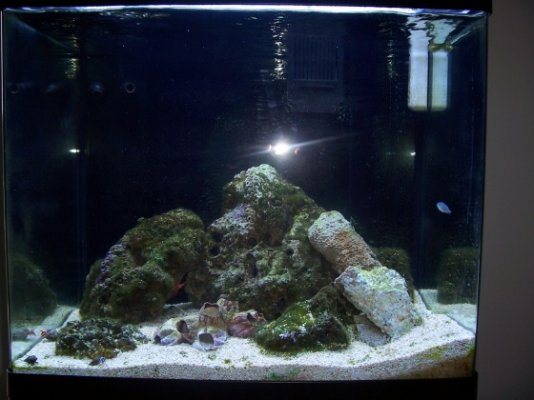dmreichman
Aquarium Advice Newbie
First time SW.
I set up my RedSea Max 34 gallon marine aquarium on 5/19/08. Went through the cycle. I added my cleaning crew after week 3, and a few more crabs week 4. Week 5 added a Blenny. Everything still going great.
The following week I added three inexpensive Damsels (Yellowtail Blue, Striped and Chromis) and they did fine. The Striped seemed to have gotten Ich early on, in which I treated with ParaGuard) Seemed to do the trick. I thought that everything was still doing well as the Ich cleared up.
About two weeks later I added a Coral Beauty and it had Ich also.
After doing quite a lot of reading in your this Forum, I've discovered that I made many mistakes, although my water specs seemed to have always been pretty good.
Temp: 78f / Salinity: 1.022 / ph: 8.2 / Ammonia: 0 / Nitrite 0.05 / Nitrate 2.5. Still not sure how to read the Alk card that came with the kit although it seems to be "normal". Protien skimmer is working very well.
I learned a valuable lesson with water changes, I didn't know to mix it 24 hours before and I may have been responsible for killing more fish after the Ich. Lesson learned!!
I lost the Blenny today and I am down to only the Chromis and my cleaning crew (crabs and shrimp).
How can I salvage my aquarium? Would the Hyposalinity procedure take care of the suspected parasite problem? and will it kill everything else in my tank?
I set up my RedSea Max 34 gallon marine aquarium on 5/19/08. Went through the cycle. I added my cleaning crew after week 3, and a few more crabs week 4. Week 5 added a Blenny. Everything still going great.
The following week I added three inexpensive Damsels (Yellowtail Blue, Striped and Chromis) and they did fine. The Striped seemed to have gotten Ich early on, in which I treated with ParaGuard) Seemed to do the trick. I thought that everything was still doing well as the Ich cleared up.
About two weeks later I added a Coral Beauty and it had Ich also.
After doing quite a lot of reading in your this Forum, I've discovered that I made many mistakes, although my water specs seemed to have always been pretty good.
Temp: 78f / Salinity: 1.022 / ph: 8.2 / Ammonia: 0 / Nitrite 0.05 / Nitrate 2.5. Still not sure how to read the Alk card that came with the kit although it seems to be "normal". Protien skimmer is working very well.
I learned a valuable lesson with water changes, I didn't know to mix it 24 hours before and I may have been responsible for killing more fish after the Ich. Lesson learned!!
I lost the Blenny today and I am down to only the Chromis and my cleaning crew (crabs and shrimp).
How can I salvage my aquarium? Would the Hyposalinity procedure take care of the suspected parasite problem? and will it kill everything else in my tank?

